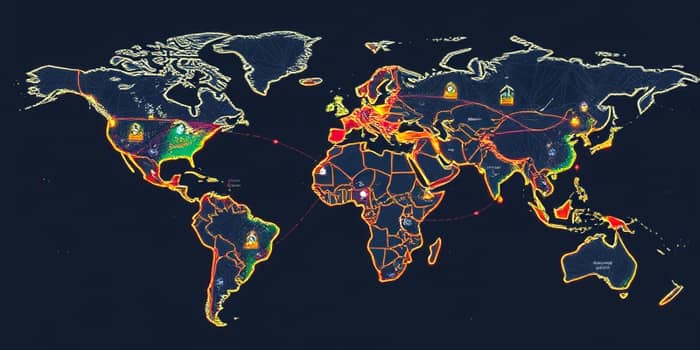
In an age of rapid technological change and geopolitical shifts, capital no longer respects national frontiers. Investors are charting new paths, seeking growth in unexpected places while navigating complex risks. This exploration offers both inspiration and practical guidance for those eager to thrive in an interconnected global economy demanding new strategies.
From bustling data hubs to renewable energy fields, every opportunity beckons. Understanding how to deploy resources effectively across borders is no longer optional—it is essential for sustained success.
The trajectory of foreign direct investment (FDI) reveals a sobering reality: global FDI fell by 11% to $1.5 trillion in 2024 and declined a further 3% in the first half of 2025. Trade, however, surged to nearly $33 trillion in 2024, underscoring resilient commerce despite political turbulence. Investors are reallocating capital toward sectors equipped to lead the next decade: AI, energy transition, digital infrastructure, and resilient real assets.
Amid these shifts, the narrative is clear: adapting to a fragmented but connected landscape is the key to unlocking long-term value across multiple asset classes.
Cross-border investment is far from monolithic. Commercial real estate in the U.S. attracted $2.4 billion in Q1 2025, up 130% year-over-year, with Canada, Norway, the UK, and Japan among the top investors. Private equity continues to flourish, with global PE reaching $1.5 trillion in deal value by Q3 2025, half of which involved cross-border transactions. Meanwhile, M&A volumes dipped 9% in H1 but deal values jumped 15%, fueled by EMEA and Asia-Pacific buyers targeting U.S. assets.
Investors now emphasize diversification across geography and sectors, reflecting a strategic pivot from pure domestic focus to balanced global portfolios.
Technology, particularly AI infrastructure and digital platforms, commands unprecedented attention. Annualized cross-border investments in data centers have topped $170 billion since 2022. With enterprise AI spending forecasted to grow at an 84% CAGR over the next five years, investors are positioning themselves at the forefront of the digital revolution.
Simultaneously, the energy transition is reshaping capital flows. Clean energy investments could hit $6.5 trillion per year by 2050. In the U.S., power demand is projected to grow 5x–7x over the next 3–5 years, spurred by electrification and AI-driven efficiencies. Renewables, nuclear, and battery storage projects are attracting major FDI, underscoring the critical importance of sustainable infrastructure investments.
While prospects are bright, cross-border investing carries inherent challenges. Regulatory regimes shift unpredictably: America First policies, expanded CFIUS oversight of greenfield investments, and outbound controls on semiconductors, AI, and biotech alter deal structures overnight. Geopolitical tensions—sanctions, tariff disputes, and regional fragmentation—add layers of complexity.
Interest rate volatility also influences cost of capital, forcing investors to refine return assumptions. Performance-driven allocation now trumps geographic allegiance, with capital flowing toward sectors and assets demonstrating resilience and growth potential.
New frontiers are emerging for those daring to look beyond established markets. In Asia, surging energy demand and China’s renewable ambitions offer fertile ground. Mexico’s proximity to the U.S. market makes it a hotspot for manufacturing and logistics. European investors are diversifying into international equity funds, committing €125 billion year-to-date into global and regional vehicles.
Deal strategies are evolving as well. Sale-leaseback arrangements in industrial real estate secure long-term income. Strategic M&A targets resilient supply chains. Multistory warehousing in Europe and Asia addresses land scarcity. For many, the goal is achieving balanced portfolios that harness regional growth dynamics.
Major transactions illustrate the transformative power of cross-border capital. Norges Bank’s $1.1 billion stake in U.S. logistics assets and a British PE firm’s $141 million hospitality purchase at PGA National Resort highlight the diversity of deals. Data center buyouts exceeding $1 billion signify the accelerating race to own digital infrastructure.
Looking ahead to H2 2025 and beyond, anticipate further expansion of PE in AI, energy, healthcare, and fintech. A recovering IPO market—driven by lower rates and geographic reopenings—will unlock new equity channels. Sustainability, digital transformation, climate resilience, and longevity will anchor investment themes, guiding capital toward projects that promise not just returns, but lasting impact.
References





